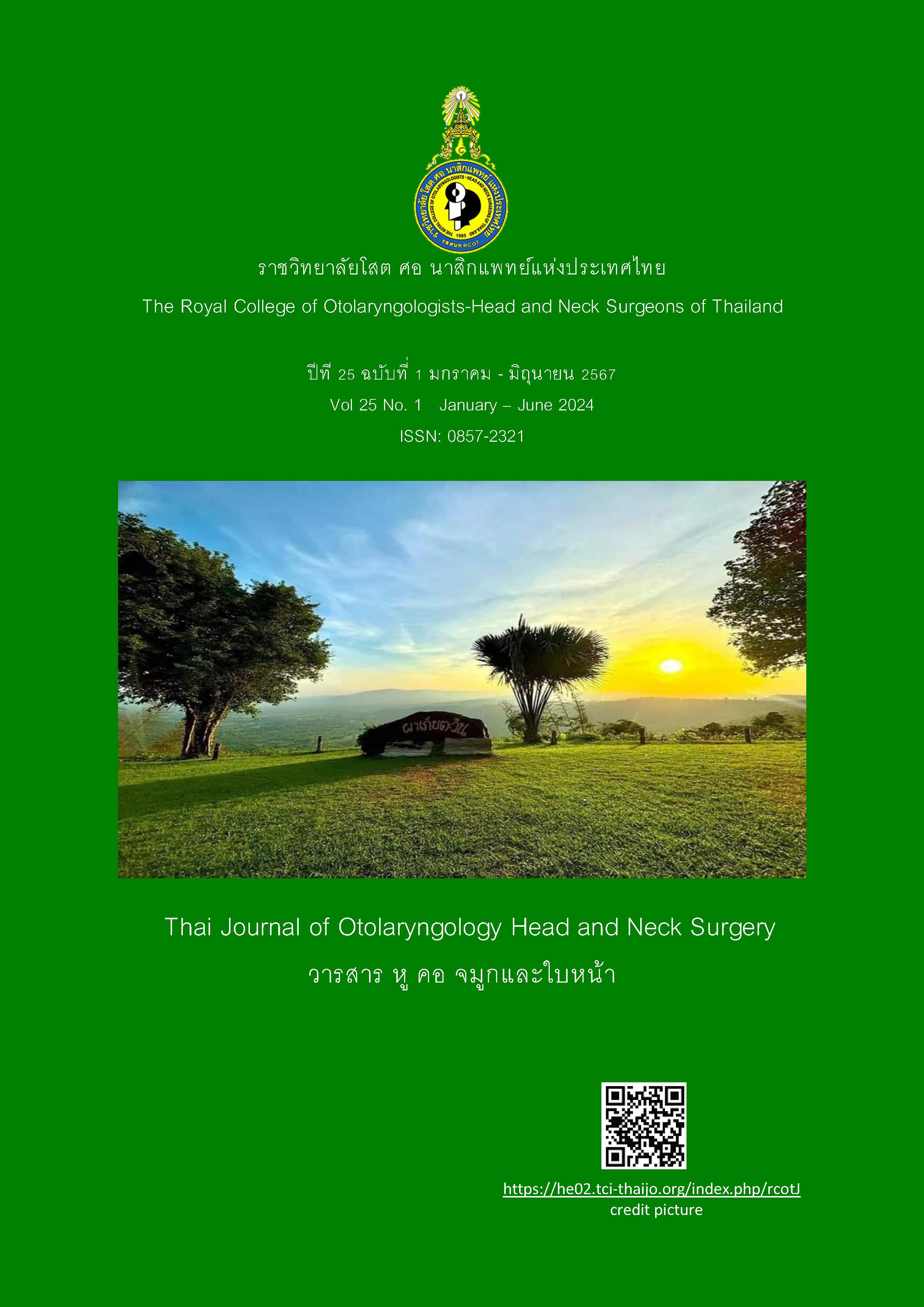Accuracy of Near-infrared Spectroscopy for Detecting Postoperative Free Flap Failure in Head and Neck Tumor Surgery with Free Flap Reconstruction ความแม่นยำของการตรวจภาวะการสูญเสียเนื้อเยื่อปลูกถ่ายด้วยเครื่อง Near-infrared Spectroscopy หลังการผ่าตัดเนื้องอกศีรษะและล าคอร่วมกับการผ่าตัดย้ายเนื้อเยื่อร่างกายและหลอดเลือด
Main Article Content
Abstract
Abstract
Background Condition of loss of graft after head and neck tumor surgery with free flap
reconstruction. This affects the patient's quality of life after surgery and also increases the
risk of repeat anesthesia to recover tissue. Therefore, after surgical tissue transfer, accurate
and efficient methods for monitoring and monitoring the ischemic state of the grafted tissue are
required.
Objectives To study the accuracy of postoperative free flap monitoring with Near-infrared
spectroscopy (NIRS) compare with the pin-prick method. To study factors associated with the
postoperative graft loss and the association of the two methods of monitoring.
Materials and methods Diagnostic descriptive study in a group of patients with head and neck tumors
who received tumor surgery with free flap reconstruction and postoperative free flap monitoring
with NIRS compare with the pin-prick method within 72 hours in the Otolaryngology Department,
Rajavithi Hospital. The data was collected between October 2022 and December 2023.
Results A total of 34 patients were found to have a tendency to lose a graft after surgery in 5
cases, which could be detected by using NIRS, with tissue oxygen levels lower than 60% in all
cases. It is an accuracy value equal to 100% compared to pin-prick method, and found that smoking,
blood loss during surgery, and the tissue oxygen level after surgery are the factor that has a
statistically significant relationship with postoperative free flap failure, with p-values equal to
0.015, 0.018, and 0.000, respectively.
Conclusion The NIRS for measuring the tissue oxygen level after surgery has the potential to be
used for postoperative free flap monitoring.
Keywords Postoperative free flap monitoring, Postoperative free flap failure, Near-infrared
spectroscopy
Article Details

This work is licensed under a Creative Commons Attribution-NonCommercial-NoDerivatives 4.0 International License.
ต้นฉบับที่ส่งมาพิจารณายังวารสารหู คอ จมูก และใบหน้า จะต้องไม่อยู่ในการพิจารณาของวารสารอื่น ในขณะเดียวกันต้นฉบับที่จะส่งมาจะผ่านการอ่านโดยผู้ทรงคุณวุฒิ หากมีการวิจารณ์หรือแก้ไขจะส่งกลับไปให้ผู้เขียนตรวจสอบแก้ไขอีกครั้ง ต้นฉบับที่ผ่านการพิจารณาให้ลงตีพิมพ์ถือเป็นสมบัติของวารสารหู คอ จมูกและใบหน้า ไม่อาจนำไปลงตีพิมพ์ที่อื่นโดยไม่ได้รับอนุญาต
ตารางแผนภูมิ รูปภาพ หรือข้อความเกิน 100 คำที่คัดลอกมาจากบทความของผู้อื่น จะต้องมีใบยินยอมจากผู้เขียนหรือผู้ทรงลิขสิทธิ์นั้นๆ และใหร้ะบุกำกับไว้ในเนื้อเรื่องด้วย
References
เอกสารอ้างอิง
Spiegel JH, Polat JK. Microvascular flap reconstruction by otolaryngologist: prevalence,
postoperative care and monitoring techniques. Laryngoscope. 2007 Mar; 117(3): 485-90.
Kohlert S, Quimby AE, Saman M, Ducic Y. Postoperative free-flap monitoring techniques. Semin
Plast Surg 2019 Feb; 33(1): 13-6.
Han ZF, Guo LL, Liu LB, et al. A comparison of the Cook- Swartz Doppler with conventional
clinical methods for free flap monitoring: a systematic review and a meta-analysis. Int J Surg.
; 32: 109–115.
Scheeren TWL, Schober P, Schwart LA. Monitoring tissue oxygenation by near infrared spectroscopy
(NIRS): background and current applications. Journal of clinical monitoring and computing. 2012; 26: 279–87.
Festa BM, Costantino A, Pace GM, Spriano G, De V i r g i l io A . Near i nf rared spectroscopy
for continuous noninvasive monitoring of free flap in head and neck reconstruction : Systematic
review of the literature and personal experience . Surg Innov. 2023;30(6):711-719.
. Czako L, Simko K, Sovis M, Vidova I, Sufliarsky B, Odnoga P, et al .Near infrared spectroscopy
in monitoring of head and neck microvascular free flaps . Bratisl Lek Listy .2023;124(7):513-519.
Cai Z, Zhang J, Zhang J, Zhao F, Yu G, Li Y, et al . Evaluation of near infrared spectroscopy in
monitoring postoperative regional tissue oxygen saturation for fibular flaps. J Plast reconstr
Aesthet Surg. 2008;61(3):289-96.
Whitaker LS, Pratt GF, Rozen WM, Cairns SA, Barrett MD, Hiew LY, et al. Near infrared
spectroscopy for monitoring flap viability following breast reconstruction. J Reconstr Microsurg.
Mar; 28(3):149-54.
. Ouyang S, Cai Z, Shan XF, Li Y. Prospective Trial of Near-Infrared Spectroscopy for Continuous
Noninvasive monitoring of Free Fibular Flaps. Ann Plast Surg. 2021; 87: e29-36.
Steele MH. Three-year experience using near infrared spectroscopy tissue oximetry monitoring of
free tissue t r ansfers. Ann P l a s t Surg. 2011 May;66(5):540-5.


